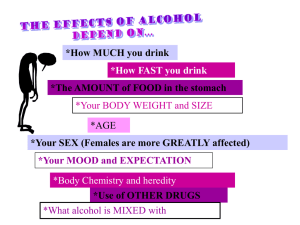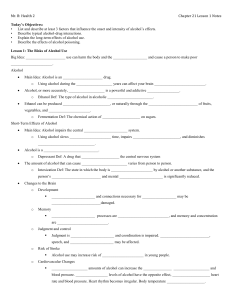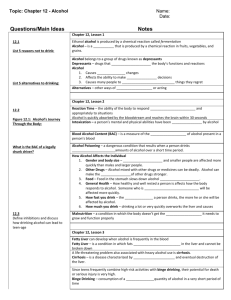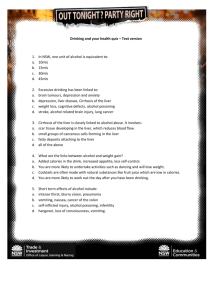Interactive body content
advertisement
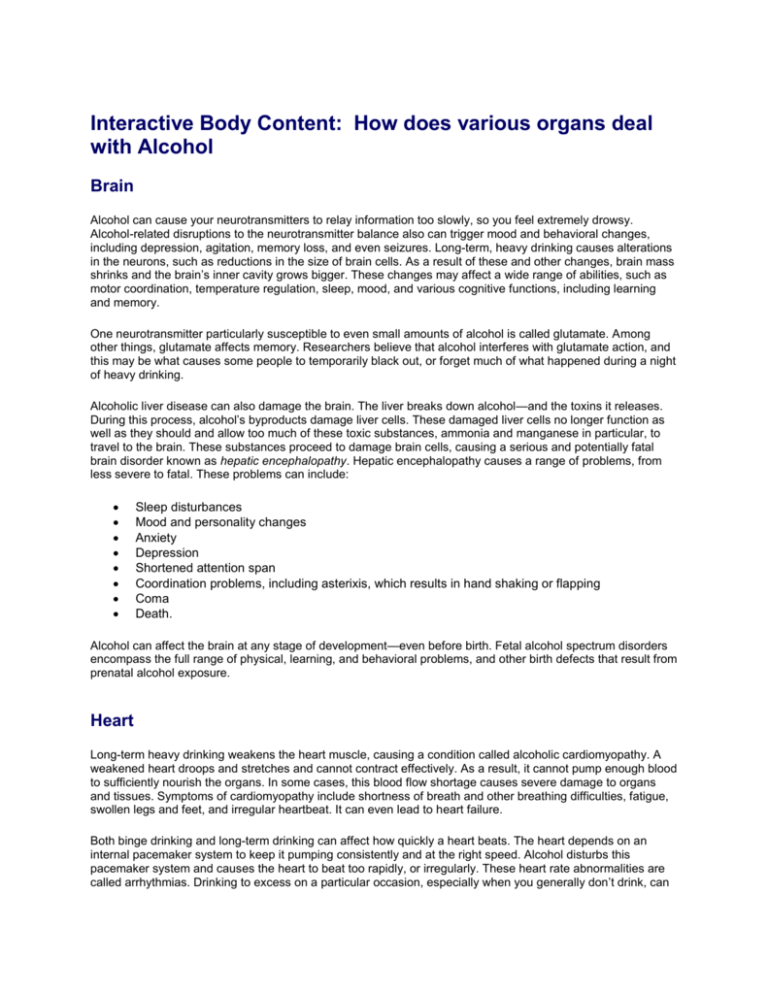
Interactive Body Content: How does various organs deal with Alcohol Brain Alcohol can cause your neurotransmitters to relay information too slowly, so you feel extremely drowsy. Alcohol-related disruptions to the neurotransmitter balance also can trigger mood and behavioral changes, including depression, agitation, memory loss, and even seizures. Long-term, heavy drinking causes alterations in the neurons, such as reductions in the size of brain cells. As a result of these and other changes, brain mass shrinks and the brain’s inner cavity grows bigger. These changes may affect a wide range of abilities, such as motor coordination, temperature regulation, sleep, mood, and various cognitive functions, including learning and memory. One neurotransmitter particularly susceptible to even small amounts of alcohol is called glutamate. Among other things, glutamate affects memory. Researchers believe that alcohol interferes with glutamate action, and this may be what causes some people to temporarily black out, or forget much of what happened during a night of heavy drinking. Alcoholic liver disease can also damage the brain. The liver breaks down alcohol—and the toxins it releases. During this process, alcohol’s byproducts damage liver cells. These damaged liver cells no longer function as well as they should and allow too much of these toxic substances, ammonia and manganese in particular, to travel to the brain. These substances proceed to damage brain cells, causing a serious and potentially fatal brain disorder known as hepatic encephalopathy. Hepatic encephalopathy causes a range of problems, from less severe to fatal. These problems can include: Sleep disturbances Mood and personality changes Anxiety Depression Shortened attention span Coordination problems, including asterixis, which results in hand shaking or flapping Coma Death. Alcohol can affect the brain at any stage of development—even before birth. Fetal alcohol spectrum disorders encompass the full range of physical, learning, and behavioral problems, and other birth defects that result from prenatal alcohol exposure. Heart Long-term heavy drinking weakens the heart muscle, causing a condition called alcoholic cardiomyopathy. A weakened heart droops and stretches and cannot contract effectively. As a result, it cannot pump enough blood to sufficiently nourish the organs. In some cases, this blood flow shortage causes severe damage to organs and tissues. Symptoms of cardiomyopathy include shortness of breath and other breathing difficulties, fatigue, swollen legs and feet, and irregular heartbeat. It can even lead to heart failure. Both binge drinking and long-term drinking can affect how quickly a heart beats. The heart depends on an internal pacemaker system to keep it pumping consistently and at the right speed. Alcohol disturbs this pacemaker system and causes the heart to beat too rapidly, or irregularly. These heart rate abnormalities are called arrhythmias. Drinking to excess on a particular occasion, especially when you generally don’t drink, can trigger either of these irregularities. Over the long-term, chronic drinking changes the course of electrical impulses that drive the heart’s beating, which creates arrhythmia. Both binge drinking and long-term heavy drinking can lead to strokes, even in people without coronary heart disease. Recent studies show that people who binge drink are about 56 percent more likely than people who never binge drink to suffer an ischemic stroke over 10 years. Binge drinkers also are about 39 percent more likely to suffer any type of stroke than people who never binge drink. In addition, alcohol exacerbates the problems that often lead to strokes, including hypertension, arrhythmias, and cardiomyopathy. Chronic alcohol use, as well as binge drinking, can cause high blood pressure, or hypertension. Your blood pressure is a measurement of the pressure your heart creates as it beats, and the pressure inside your veins and arteries. Heavy alcohol consumption triggers the release of certain stress hormones that in turn constrict blood vessels. This elevates blood pressure. In addition, alcohol may affect the function of the muscles within the blood vessels, causing them to constrict and elevate blood pressure. Liver There probably isn’t a more vital—yet underappreciated—organ in the human body than the liver. While we may recognize, in the most general terms, the role that the liver plays, many of us don’t fully understand its many functions or vulnerabilities, particularly with regard to alcohol. And yet the alcohol-liver connection is critical, as more than 2 million Americans suffer from liver disease caused by alcohol. By performing more than 500 different functions, the liver is essential to our health. Its primary role is to filter all the blood in our bodies by breaking down and eliminating toxins and storing excess blood sugar. It also produces enzymes that break down fats, manufactures proteins that regulate blood clotting, and stores a number of essential vitamins and minerals. All told, the liver keeps us alive by enabling us to digest food, absorb nutrients, control infections, and get rid of toxic substances in our bodies. While liver problems can be inherited, or developed in response to certain viruses or chemicals, excessive alcohol use plays a major role. To the human body, alcohol is a toxin that is broken down by the liver as the body begins the process of getting rid of these foreign components. However, chronic heavy drinking causes the liver to become fatty. This condition makes the liver more vulnerable to dangerous inflammation, such as alcoholic hepatitis, and its associated complications. With continued drinking, persistent inflammation causes fibrous tissue to increase in the liver, which prevents the necessary blood supply from reaching the liver cells. Without the oxygen and other nutrients supplied by this blood, the liver cells eventually die and are replaced with scar tissue, creating a condition known as cirrhosis. In mild cases, the liver can actually make repairs and continue to function. However, advanced cirrhosis causes continued deterioration and liver failure. In some cases, lifestyle changes can help treat alcohol-liver problems. Abstinence from alcohol, along with better nutrition and quitting smoking, can help prevent further injury and keep liver diseases in check. In extreme cases, however, a liver transplant may be the primary treatment option. Pancreas A pancreas unaffected by alcohol sends enzymes out to the small intestine to metabolize food. Alcohol jumbles this process. It causes the pancreas to secrete its digestive juices internally, rather than sending the enzymes to the small intestine. These enzymes, as well as acetaldehyde— a substance produced from metabolizing, or breaking down the alcohol—are harmful to the pancreas. If you consume alcohol excessively over a long time, this continued process can cause inflammation, as well as swelling of tissues and blood vessels. This inflammation is called pancreatitis, and it prevents the pancreas from working properly. Pancreatitis occurs as a sudden attack, called acute pancreatitis. As excessive drinking continues, the inflammation can become constant. This condition is known as chronic pancreatitis. Pancreatitis is also a risk factor for the development of pancreatic cancer. A heavy drinker may not be able to detect the buildup of pancreatic damage until the problems set off an attack. An acute pancreatic attack causes symptoms including: Abdominal pain, which may radiate up the back Nausea and vomiting Fever Rapid heart rate Diarrhea Sweating. Chronic pancreatitis causes these symptoms as well as severe abdominal pain, significant reduction in pancreatic function and digestion, and blood sugar problems. Chronic pancreatitis can slowly destroy the pancreas and lead to diabetes or even death. Stomach The stomach is designed to process and transport food. Ingesting healthy foods makes this organ run smoothly. After ingestion, alcohol travels down the esophagus into the stomach, where some of it is absorbed into your bloodstream. The unabsorbed alcohol continues to move through the gastrointestinal tract. The majority of it will enter the small intestine and get absorbed into the bloodstream through the walls of the small intestine, or it can stay in the stomach and cause irritation. While in the stomach, alcohol acts as an irritant and increases digestive juices (hydrochloric acid) that are secreted from the stomach lining. Intoxicating amounts of alcohol can halt the digestive process, robbing the body of vital vitamins and minerals. Chronic irritation may lead to damage to the lining of the stomach. Drinking alcohol and taking medication that causes stomach irritation, such as aspirin, can cause gastritis (inflammation of the stomach lining), ulcers, and severe bleeding. Kidneys Binge drinking or chronic alcohol consumption can interfere with kidney function directly, or indirectly as a consequence of liver disease. Normally the rate of blood flow through the kidneys is tightly controlled, so that plasma can be filtered and substances the body needs, such as electrolytes (electrically charged particles, or ions), can be reabsorbed under optimal circumstances. Established liver disease impairs this important balancing act, however, by either greatly augmenting or reducing the rates of plasma flow and filtration through a mass of capillaries called the glomerul. One of the main functions of the kidneys is to regulate both the volume and the composition of body fluid, including electrolytes, such as sodium, potassium, and chloride ions. However, alcohol can have the diuretic effect of increasing urine volume. This in turn can change the body’s fluid level and disturb the electrolyte balance. Alcohol can augment urine flow within 20 minutes of consumption. As a result of urinary fluid losses, the concentration of electrolytes in blood serum increases. These changes can be profound in chronic alcoholic patients, who may demonstrate clinical evidence of dehydration. Lungs It only recently has been recognized that alcohol abuse also increases the risk of acute lung injury following major trauma, such as a serious motor vehicle accident, gunshot, or other event requiring hospitalization, or the spread of bacteria attributed to infection (i.e., sepsis). The well-known acute intoxicating effects of alcohol and the concomitant risk of aspiration of secretions or foreign material into the trachea and lungs are components in the development of alcohol-associated lung (i.e., pulmonary) disease. In the past decade, clinical and experimental evidence has emerged that implicates a chronic imbalance in the cell (i.e., oxidative stress) and consequent cellular dysfunction within the layer of tissue lining the airway (i.e., airway epithelium) as well as pathogen-ingesting white blood cells (i.e., macrophages) in the airway. Moreover, now it is recognized that these disruptions in lung function can occur even in young and otherwise healthy individuals long before they develop clinically apparent signs of alcoholinduced organ damage such as liver disease and/or other end-stage manifestations of longstanding alcohol abuse. Based on these recent studies, the concept of the alcoholic lung is emerging, which is characterized by severe oxidative stress that alone may not cause detectable lung impairment but may predispose those who are dependent on or abuse alcohol to severe lung injury if they are unfortunate enough to suffer serious trauma or other acute illnesses, and makes them more prone to lung infections. (Collegedrinkingprevention.gov)
